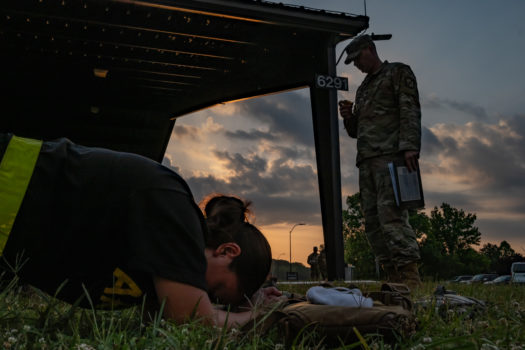Only four hours into a new day, the Cadets from 4th Regiment are awake and ready to perform to the best of their abilities for the Army Combat Fitness Test. Located under a large turfed pavilion surrounded by a mile-long circular track, the ACFT aims to put a Cadet’s physical prowess to the test in a series of six back-to-back events.
The six events are the deadlift, standing power throw, hand release push-ups, plank, and the sprint-drag-carry. These events all cumulate into the final challenge; a two-mile run.

The ultimate goal of the ACFT is to score a perfect 600 points across all six events. For Cadet Christopher Rerig from Embry-Riddle Aeronautical University, who scored a 589, that goal came ever so close.
“[my score was] a little suboptimal for what I normally do,” said Rerig, “[I score in the] mid 590s ever since they switched over to the planks.”
Although the current iteration of the ACFT is relatively new, it wasn’t Rerig’s first time taking the fitness test.
“It’s decent for (assessing) overall strength, but there’s definitely techniques you could do to … make yourself look a little better,” said Rerig.
As someone so close to approaching a perfect score, Rerig is consistently thinking of ways in which to improve in particular events.
In reference to the plank, Rerig said, “It’s a mind game. You can just zone out and you’re in it.”
As for the standing power throw, Rerig considers that challenge to be all technique.
“It’s hip flexors and lats,” said Rerig. “Pull it over your head. If you get a deep squat and release at the right point, as long as you have the trajectory down, your ball’s sailing.”
It might be said that a part of Rerig’s success stems from commitment just as much as from technique. The Cadet had wanted some part to play in the military since he was a child.
“I grew up in a military community,” said Rerig. “I kind of already had that drive for service. I think it’s just the best way to develop my leadership skills and grow, not only for military life but professional experiences afterwards.”
Rerig is certain of where this growth will lead him.
“I want to become an explosive ordinance disposal officer and do my full 20 years. I’ll reevaluate my Army career right about that point. If they want me to stay and I have an opportunity to grow, I’m going to continue to do so.”
As much as Rerig may know that military life is right for him, he recognizes that some people may still be uncertain about proceeding into such a career. For those still on the fence, he offered some advice.
“Make sure it’s what you want to do,” said Rerig. “If you don’t have the right attitude, you’re not going to get along with people you work with and no one is going to respect that kind of leadership or subordinate action.”

His advice also included taking care of your body in preparation for challenges such as the ACFT.
“Take your physical training seriously,” said Rerig. “Go to PT (physical training) in the morning, go and do any kind of extra work. Army PT is to maintain not to get better so if you can get in the gym and do your cardio, do whatever you have to do to fix those deficiencies. That’s your best bet.”




